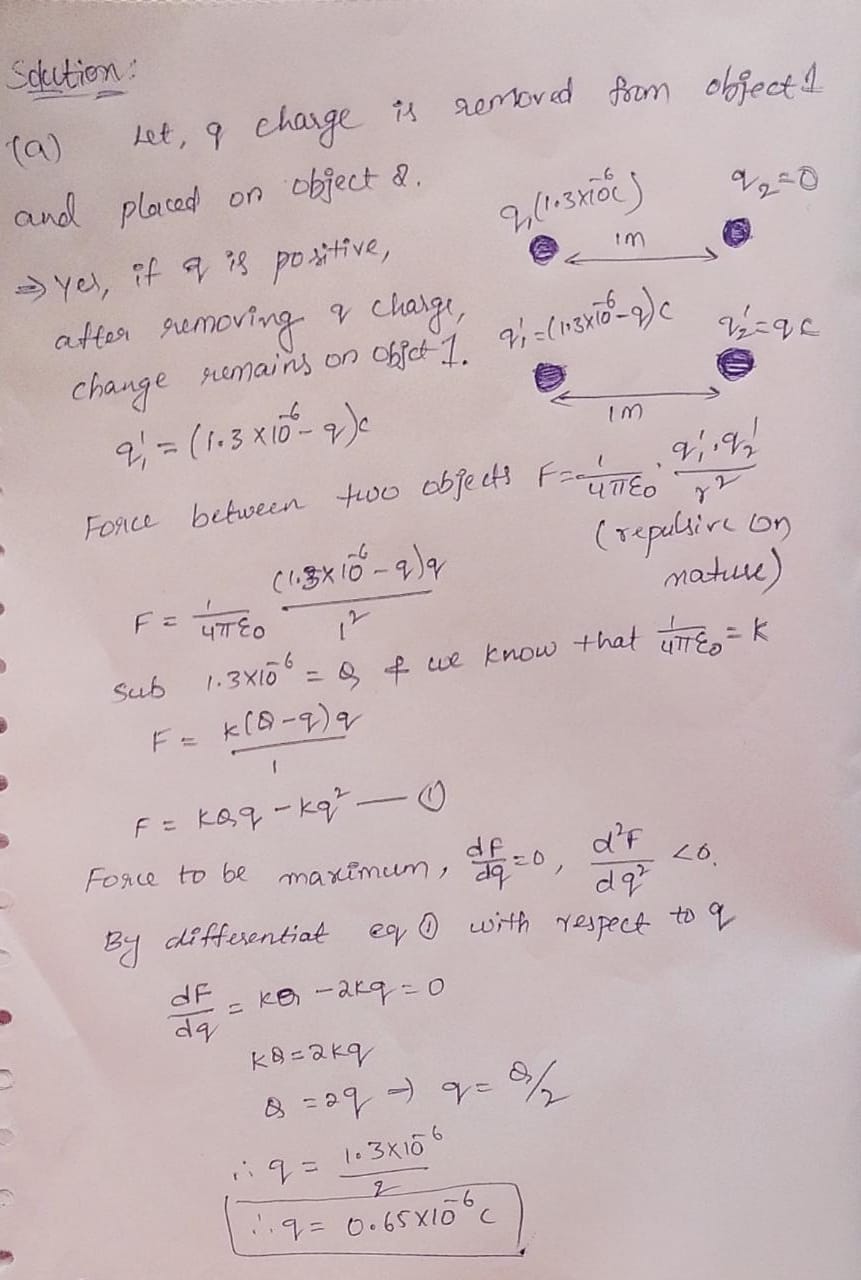3. A small object has charge +1.3 x 10-°C. A certain amount of charge q is removed from it and placed on a second small object. The two objects are placed 1 m apart. For the following two questions, if your answer is “Yes", please determine the value for q; if your answer is “No", please briefly explain the reason. A. If we know q is positive, then can you find what should be q to make the electric force that each object exerts on the other to be a maximum? B. If we do not know whether q is positive or negative, then can you find what should be q to make the electric force that each object exerts o the other to be a maximum?
3. A small object has charge +1.3 x 10-°C. A certain amount of charge q is removed from it and placed on a second small object. The two objects are placed 1 m apart. For the following two questions, if your answer is “Yes", please determine the value for q; if your answer is “No", please briefly explain the reason. A. If we know q is positive, then can you find what should be q to make the electric force that each object exerts on the other to be a maximum? B. If we do not know whether q is positive or negative, then can you find what should be q to make the electric force that each object exerts o the other to be a maximum?
College Physics
11th Edition
ISBN:9781305952300
Author:Raymond A. Serway, Chris Vuille
Publisher:Raymond A. Serway, Chris Vuille
Chapter1: Units, Trigonometry. And Vectors
Section: Chapter Questions
Problem 1CQ: Estimate the order of magnitude of the length, in meters, of each of the following; (a) a mouse, (b)...
Related questions
Question
100%

Transcribed Image Text:3. A small object has charge +1.3 x 10-°C. A certain amount of charge q is removed
from it and placed on a second small object. The two objects are placed
1m apart. For the following two questions, if your answer is “Yes", please determine
the value for q; if your answer is "No", please briefly explain the reason.
A. If we know q is positive, then can you find what should be q to make the
electric force that each object exerts on the other to be a maximum?
B. If we do not know whether q is positive or negative, then can you find what
should be q to make the electric force that each object exerts o the other to be
a maximum?
Expert Solution
Step 1

Trending now
This is a popular solution!
Step by step
Solved in 2 steps with 2 images

Knowledge Booster
Learn more about
Need a deep-dive on the concept behind this application? Look no further. Learn more about this topic, physics and related others by exploring similar questions and additional content below.Recommended textbooks for you

College Physics
Physics
ISBN:
9781305952300
Author:
Raymond A. Serway, Chris Vuille
Publisher:
Cengage Learning

University Physics (14th Edition)
Physics
ISBN:
9780133969290
Author:
Hugh D. Young, Roger A. Freedman
Publisher:
PEARSON

Introduction To Quantum Mechanics
Physics
ISBN:
9781107189638
Author:
Griffiths, David J., Schroeter, Darrell F.
Publisher:
Cambridge University Press

College Physics
Physics
ISBN:
9781305952300
Author:
Raymond A. Serway, Chris Vuille
Publisher:
Cengage Learning

University Physics (14th Edition)
Physics
ISBN:
9780133969290
Author:
Hugh D. Young, Roger A. Freedman
Publisher:
PEARSON

Introduction To Quantum Mechanics
Physics
ISBN:
9781107189638
Author:
Griffiths, David J., Schroeter, Darrell F.
Publisher:
Cambridge University Press

Physics for Scientists and Engineers
Physics
ISBN:
9781337553278
Author:
Raymond A. Serway, John W. Jewett
Publisher:
Cengage Learning

Lecture- Tutorials for Introductory Astronomy
Physics
ISBN:
9780321820464
Author:
Edward E. Prather, Tim P. Slater, Jeff P. Adams, Gina Brissenden
Publisher:
Addison-Wesley

College Physics: A Strategic Approach (4th Editio…
Physics
ISBN:
9780134609034
Author:
Randall D. Knight (Professor Emeritus), Brian Jones, Stuart Field
Publisher:
PEARSON